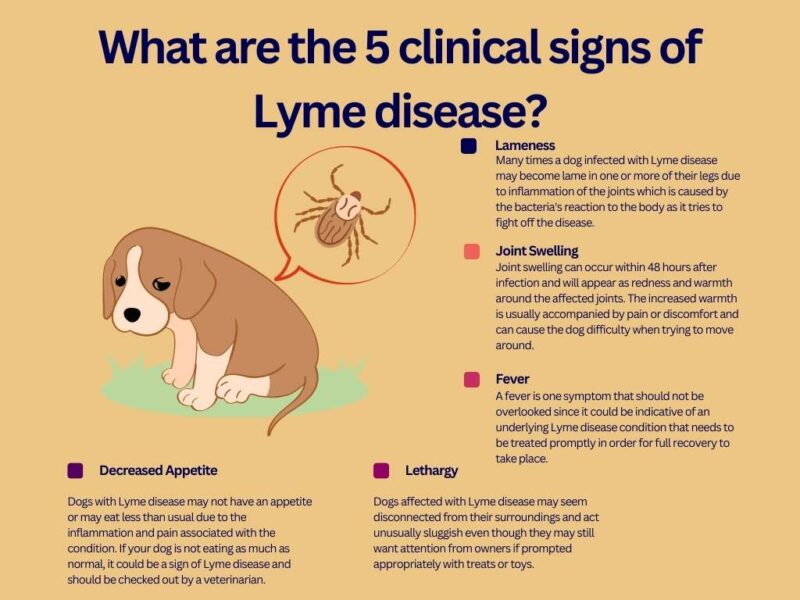5 Facts You May Not Know About Lyme Disease in Dogs
Introduction
Maggie was a proud and attentive dog owner who loved spending time outdoors with her Golden Retriever, Daisy. Together, they enjoyed countless hikes and adventures in the great outdoors. But when Daisy started acting lethargic and showing signs of joint pain, Maggie’s concern grew. After a visit to the vet, she was shocked to learn that Daisy had contracted Lyme disease. This diagnosis led Maggie down a path of discovery, as she realized there was so much she didn’t know about this potentially dangerous condition.
Lyme disease in dogs, a bacterial ailment brought about by Borrelia burgdorferi, is an issue that can affect our canine companions considerably. Transmitted through the bite of a black-legged or deer tick, it is one of the most common tick-related diseases worldwide. The initial infection can yield a spectrum of signs, ranging from slight discomfort to serious health hazards.
In this article, we aim to reveal five less-discussed facts about Lyme disease in dogs, diving into aspects that may have slipped under your radar, from its roots and noticeable symptoms to contemporary treatment methods and preventive strategies. We firmly believe that knowledge is pivotal in preserving our pets’ health.
Consequently, whether you are a seasoned pet parent or have just welcomed a new dog into your family, we encourage you to read on. Equip yourself with crucial information to guard your beloved pet against most Lyme disease scenarios and other potential flea and tick-borne complications.
Signs of Lyme Disease in Dogs

1. Transmission is Relatively Fast
Borrelia burgdorferi, the bacterium responsible for causing Lyme disease, is hosted by ticks and is transmitted to dogs and other animals via the bite of these tiny parasites. Contrary to a common belief among pet owners that a tick needs to remain attached for 24-48 hours for Lyme disease to be transmitted, recent studies suggest a considerably shorter time frame. Evidence shows that the disease can be transmitted within 15-24 hours of the tick’s first attachment.
This insight implies that it doesn’t necessarily require extended durations of tick attachment to put your dog at risk of infection. The mere action of the tick attaching itself and starting to feed sets the stage for potential disease transmission. While Lyme disease affects both people and dogs, only about 10% of dogs exposed to Lyme disease get sick, as reported by the Centers for disease control.
This vital information underscores the need for regular and meticulous tick inspections, especially following outdoor activities where ticks might be abundant. Swift detection and removal of ticks can significantly lower the chance of your dog contracting Lyme disease and the health issues that come with it, including affecting the kidneys and symptoms like vomiting in severe cases.
To protect your pet from these potential health threats, speak with your veterinarian and explore preventive measures, particularly if your dog exhibits symptoms in one or more joints.
2. Dogs Can Develop Lyme Nephritis
Lyme nephritis, a potentially fatal kidney condition in dogs, can emerge as a complex offshoot of Lyme disease. It materializes when the immune response to the bacterium that triggers Lyme disease, Borrelia burgdorferi, incites kidney inflammation. This inflammatory action disrupts standard kidney function, spiraling toward chronic kidney disease and, in severe cases, kidney failure.
Although Lyme nephritis is a rarer yet extremely critical complication of Lyme disease, it underlines the importance of preventing it. This prevention can be achieved through regular tick control and vaccination. Early detection and treatment of Lyme disease, especially during the initial infection phase, are crucial in sidestepping this and other serious complications. Though research is still being carried out to understand the precise mechanism leading to Lyme nephritis’s development, certain dog breeds like Labrador Retrievers and Golden Retrievers seem to have a heightened susceptibility.
It’s essential to monitor for signs of illness in your pet and consult a vet if common signs such as fever emerge. They may recommend additional tests to ensure your pet’s health and well-being.
3. Lyme Disease in Dogs Can Affect Everywhere
Contrary to widespread belief, Lyme disease isn’t solely confined to particular geographic zones, such as the Northeastern United States, where it was initially discovered. In fact, it is estimated by the Centers for Disease Control and Prevention that Lyme disease affects around 300,000 individuals yearly in the United States alone. Although it’s undeniable that Lyme disease shows a higher prevalence in regions with sizable tick populations, the reality is that Lyme infections have been diagnosed in dogs across all states in the U.S. and many other global locations.

Ticks, especially the Ixodes, or ‘black-legged’ ticks, which are carriers of Borrelia burgdorferi (the bacterium responsible for Lyme disease), are highly adaptable creatures that can thrive in diverse habitats – from woodlands and grasslands to even urban areas. The combination of shifting climate conditions and wildlife migration patterns contributes to the wider spread of ticks into fresh territories.
Therefore, irrespective of your residence, if your dog frequently ventures outdoors, there is a potential risk of exposure to Lyme disease. This reinforces the necessity for round-the-year tick prevention strategies, regular veterinarian visits, and considering a vaccination if your dog is in the upper Midwest or any other area with a high risk of exposure.
Additionally, it is important to conduct tests such as the SNAP 4Dx Plus test and Quant C6 test to quickly identify and treat any direct source of infection, reducing the time a tick can transmit Lyme disease.
4. Most Deer Ticks are Infected with Lyme Disease
The Black-legged tick, also known as the deer tick, is the primary vector for Lyme disease. These ticks become infected with the bacterium that causes Lyme disease, Borrelia burgdorferi when they feed on infected hosts such as mice and birds.
It’s crucial to note that not all deer ticks are infected with Lyme disease, and the percentage of infected ticks can vary greatly by region. Some studies suggest that up to 50% of deer ticks may carry the bacterium in areas where Lyme disease is highly prevalent. However, the percentage of infected ticks can be significantly lower in other regions where the disease is less common.
It’s also important to know that a tick must be attached to your dog for at least 24-48 hours to transmit the bacteria. This highlights the importance of daily tick checks and promptly removing any ticks found on your dog. While the presence of deer ticks in an area does increase the risk of Lyme disease, it does not guarantee that every tick carries the bacteria or that every bite will result in infection. Effective tick prevention measures and quick removal of ticks are key to minimizing the risk of Lyme disease.
Deer Ticks are Tiny
It’s essential to realize that deer ticks, also known as black-legged ones, are incredibly small. In their nymph stage, which is the most dangerous in terms of Lyme disease transmission, they can be as tiny as a poppy seed. This makes them incredibly hard to spot, especially on a dog with a thick coat. Adult ticks are larger, about the size of a sesame seed, but can still be easily missed. This highlights the importance of regular, thorough tick checks for dogs, particularly after being outdoors, where ticks are prevalent.
Deer Ticks Can Survive Frigid Temperatures
Many believe ticks are only a problem in warmer months, but this is only partially accurate. Deer ticks are incredibly resilient and can survive very low temperatures, some even below freezing. They become dormant under snow cover and can become active again when the temperature rises. Ticks can also survive in freezing temperatures by seeking shelter in leaf litter on the forest floor. This is why veterinarians recommend year-round tick prevention, as your dog may still be exposed to ticks in colder months.
5. Lyme Disease Can Be Fatal
Though many dogs with Lyme disease will only experience mild symptoms, the disease can be life-threatening in rare instances. This is typically due to a condition known as Lyme nephritis. Lyme nephritis is an uncommon but serious complication of Lyme disease where the dog’s immune system overreacts to the infection, causing inflammation and kidney damage.
Unfortunately, dogs with Lyme nephritis often have a poor prognosis, with many dogs succumbing to rapidly progressing kidney failure despite aggressive treatment. This is why prevention and early detection of Lyme disease is so critical. Even though such serious consequences are rare, the potential risk underscores the importance of protecting dogs from ticks and Lyme disease.
How Can You Protect Your Dog from Lyme Disease?
There are several ways you can protect your dog from Lyme disease:
- Tick Prevention Products: Utilize tick prevention products, such as spot-on treatments, chewable tablets, and tick collars designed to kill and repel ticks. These work by releasing chemicals that kill ticks on contact or disrupt their nervous system, leading to death. Applying or administering these products exactly as your vet or manufacturer directs is essential for maximum effectiveness.
- Vaccination: A Lyme disease vaccine for dogs can offer additional protection. The vaccine works by stimulating your dog’s immune system to produce antibodies against the bacteria that cause Lyme disease. It’s generally given to dogs at high risk due to their location or lifestyle, but it’s only typically recommended for some dogs. Talk to your vet about whether the Lyme disease vaccine would benefit your dog.

- Regular Checks: Regularly conducting thorough tick checks on your dog can help catch any ticks before they have a chance to transmit the disease. Use your fingers to feel for small bumps, particularly around the ears, neck, and between the toes, and visually inspect these areas closely. Ticks can be as small as a pinhead, so these checks should be as detailed as possible.
- Prompt Tick Removal: If you find a tick, remove it immediately to minimize disease transmission. Use tweezers to grasp the tick as close to your dog’s skin as possible, and pull it out slowly, taking care not to leave any parts of the tick behind. Avoid crushing the tick, as this can cause it to release disease-carrying fluids.
- Keep Your Yard Tick-Free: Regular yard maintenance can help minimize tick populations. Keep grass mowed short, remove leaf litter, and prune trees and shrubs to let in as much sunlight as possible (ticks prefer shady, moist areas). Using pesticide treatments designed for ticks can also be an effective part of a comprehensive tick control strategy.
- Consult your Vet Regularly: Routine veterinary examinations are crucial for early detection of Lyme disease. Your vet can perform blood tests to check for Lyme disease antibodies in your dog’s system. If your dog tests positive, treatment can begin immediately, which can significantly improve your dog’s prognosis.
Remember, even with the most rigorous preventive measures; no method can guarantee that a dog will never get a tick or contract Lyme disease. Therefore, strategies and regular vet check-ups provide the best protection.
Frequently Asked Questions
Disclaimer: The information provided on this veterinary website is intended for general educational purposes only and should not be considered as a substitute for professional veterinary advice, diagnosis, or treatment. Always consult a licensed veterinarian for any concerns or questions regarding the health and well-being of your pet. This website does not claim to cover every possible situation or provide exhaustive knowledge on the subjects presented. The owners and contributors of this website are not responsible for any harm or loss that may result from the use or misuse of the information provided herein.







